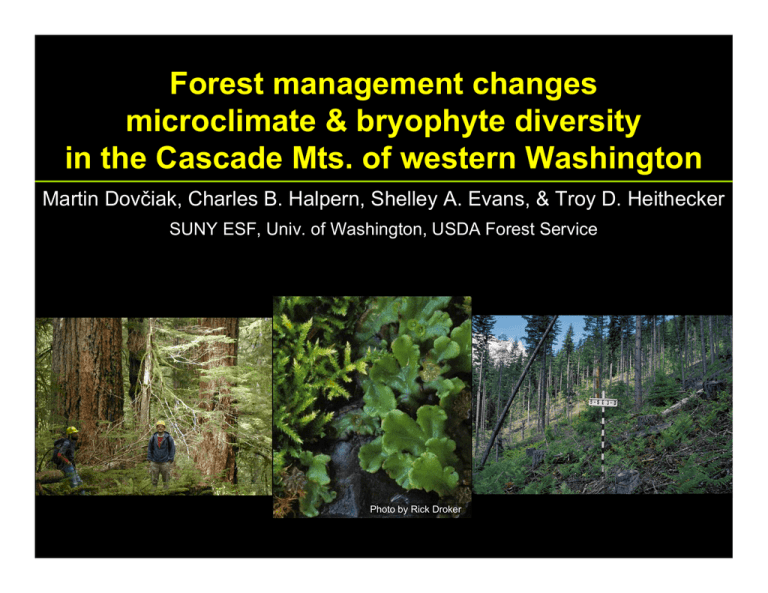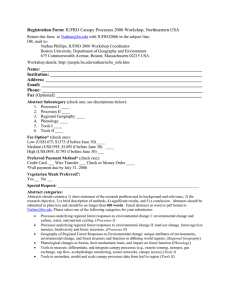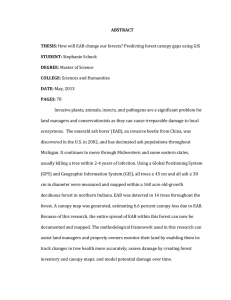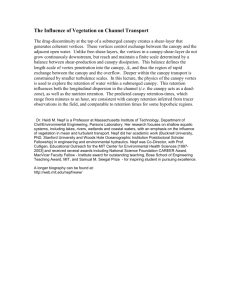Forest management changes microclimate & bryophyte diversity
advertisement

Forest management changes microclimate & bryophyte diversity in the Cascade Mts. of western Washington Martin Dovčiak, Charles B. Halpern, Shelley A. Evans, & Troy D. Heithecker SUNY ESF, Univ. of Washington, USDA Forest Service Photo by Rick Droker Global changes in land use Source: World Resources Institute / South Dakota State University, 2009 Intact Forest Landscapes Working Forest Landscapes Land use changes threaten biodiversity Sala et al. (Science 287, 2000): Global Biodiversity Scenarios for the Year 2100 Biodiversity loss may affect ecosystem stability Tilman et al. (Nature 441, 2006) Dovčiak & Halpern (Ecol. Lett. 13, 2010) Ecosystem stability (μ/σ) Mean population stability 0.9 0.6 0.3 Realized species number 5 10 Mean Richness 15 Individual species important for ecosystem function M. Vieira A. Syred www.stevesforums.com Significance of forest trees for bryophytes ¾ Forest canopy reduces solar radiation and thus affects microclimate temperature moisture ¾ Trees provide important microhabitats Decaying logs Tree trunks Forest Floor Forest management in Pacific Northwest ¾ Policy: Northwest Forest Plan (NWFP) in 1994 No clear-cuts on federal lands At least 15% of canopy trees retained in harvested areas to mediate environmental changes due to harvest ¾ Science: DEMO Study in 1994 (Demonstration of Ecosystem Management Options) Examine effects of canopy removal on forest species Vascular plants Bryophytes Fungi Birds Small mammals Insects Study hypotheses Bryophytes can be negatively affected by canopy removal (Dovčiak et al. Can. J. For. Res. 36, 2006) H-1. Bryophytes negatively affected on longer time scales richness, abundance, and liverwort proportion H-2. Bryophytes negatively affected in all microhabitats forest floor, decayed logs, and tree bases (NE vs. SW) H-3. Patterns of bryophyte decline are consistent with microclimatic changes caused by canopy removal Study area – Cascade Mts., western Washington ¾ 3 sites mid-elevations (825-1280 m) mature forests (70-170 years) Douglas-fir dominated (Pseudotsuga menziesii) Mt. St. Helens Mt. Adams Experimental design ¾ 3 sites (blocks) Treatment (retention level) 100% ( control) 40% 15% ¾ 3 treatments Decaying logs ¾ 4 microhabitats Forest floor ¾ Total of 576 quadrats (20 × 50 cm) 16 quadrats per microhabitat and treatment unit ¾ Sampled 8 years after canopy removal Tree bases (NE & SW) Canopy structure after treatments Treatment (retention level) 100% (control) 40% 15% a 40 60 c 30 40 b 20 20 c c 0 100 40 b 15 0 Canopy retention (%) 10 0 a a 100 40 15 0 Canopy retention (%) Air temp. max. (ºC) 80 PPFD (mols m-2 day-1) Basal area (m2ha-1) Effects of canopy structure on microclimate 35 30 b b ab a 25 20 100 40 15 0 Adapted from Heithecker & Halpern (For. Ecol. Manage. 226, 2006) No. of spp. per quadrat Richness of bryophytes 6 Decaying logs a P < 0.0001 5 b 4 3 P < 0.0001 5 4 c Tree bases 6 5 c 1 1 1 0 0 0 5 15 Canopy retention (%) 1 100 b 1 100 3 40 cn.s. 2 2 3 40 a 3 b 2 1 100 Forest floor 4 a 3 6 3 40 5 15 Canopy retention (%) 5 15 Canopy retention (%) Abundance of bryophytes Decaying logs Cover (%) 50 a Tree bases P < 0.0001 Forest floor P < 0.0001 a b P < c0.01 40 30 20 a ab b 10 0 a b c 100 1 40 3 15 5 Canopy retention (%) b b 100 1 40 3 15 5 Canopy retention (%) 100 1 40 3 15 5 Canopy retention (%) Response of liverworts vs. mosses ¾ Liverworts Less resilient to drought & heat stress Scapania bolanderi ¾ Mosses More resilient to drought & heat stress Hylocomium splendens Liverworts (%) Proportion of liverworts in bryophyte community 30 20 Decaying logs n.s. n.s. P < 0.001 a 10 0 Forest floor Tree bases 1 100 b b 3 40 5 15 Canopy retention (%) 1 100 3 40 5 15 Canopy retention (%) 1 100 3 40 5 15 Canopy retention (%) P < 0.02 5 4 No. of spp. per quadrat Northeast 6 a a 3 b 2 1 0 1 100 3 40 5 15 Southwest 6 P < 0.0001 5 4 a 3 b 2 c 1 0 1 100 3 40 5 15 Canopy retention (%) Canopy retention (%) Diff. in no. of spp. (NE minus SW) No. of spp. per quadrat Aspect effects on tree bases on richness 4 Richness difference P < 0.0001 3 b 2 b 1 0 a 1 100 3 40 5 15 Canopy retention (%) Hypotheses revisited H-1. Bryophytes negatively affected over longer time scales Yes: even after 8 years after logging H-2. Bryophytes negatively affected in all microhabitats Yes: decayed logs > tree trunks > forest floor Yes: SW > NE side of tree trunks H-3. Patterns of bryophyte decline are consistent with microclimatic changes caused by canopy removal Yes: for differences among treatments Yes: for differences among aspects of tree trunks Conclusions & implications ¾ Canopy retention under 40% does not preserve overall bryophyte diversity and abundance ¾ Current management prescription to retain ≥ 15% of canopy is not sufficient ¾ Global climate change (warming, droughts) is likely to exacerbate the effects of timber harvest Photos by Rick Droker Acknowledgements Funding: USDA Forest Service and PNW Research Station DEMO research partners: USDA Forest Service Region 6 Pacific Northwest Research Station University of Washington Oregon State University University of Oregon Gifford Pinchot and Umpqua N.F. Washington DNR Web site: http://www.fs.fed.us/pnw/rmp/demo/ Rick Droker






